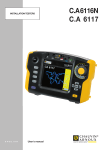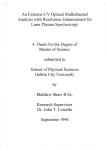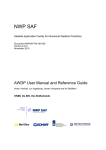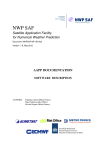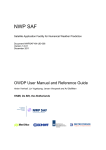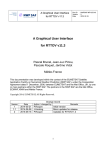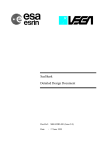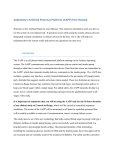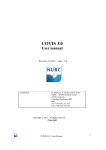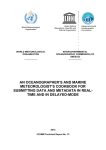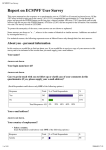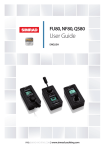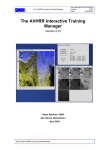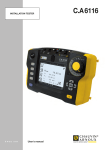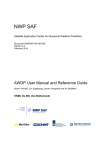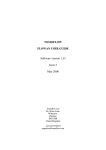Download IASI Principal Components in AAPP: User Manual
Transcript
NWP SAF
IASI Principal
Components in AAPP:
User Manual
Version 1.0
NWPSAF-MO-UD-022
Date: January 2010
Satellite Application Facility
for Numerical Weather Prediction
Document NWPSAF-MO-UD-022
Version 1.0
January 2010
IASI Principal Components in AAPP: User
Manual
Nigel Atkinson
Met Office
1
NWP SAF
IASI Principal
Components in AAPP:
User Manual
Version 1.0
NWPSAF-MO-UD-022
Date: January 2010
This documentation was developed within the context of the EUMETSAT Satellite Application
Facility on Numerical Weather Prediction (NWP SAF), under the Cooperation Agreement dated
16 December 2003, between EUMETSAT and the Met Office, UK, by one or more partners within
the NWP SAF. The partners in the NWP SAF are the Met Office, ECMWF, KNMI and Météo France.
COPYRIGHT 2009, EUMETSAT, ALL RIGHTS RESERVED.
Version
Date
0.1
0.2
1.0
10/03/2009
21/09/2009
20/01/2010
Change record
Author /
changed by
1st draft
Nigel Atkinson
Nigel Atkinson
Nigel Atkinson
Initial release
2
Remarks
NWP SAF
IASI Principal
Components in AAPP:
User Manual
Version 1.0
NWPSAF-MO-UD-022
Date: January 2010
Contents
1. Introduction ....................................................................................................................... 4
2. Requirements.................................................................................................................... 4
3. BUFR encode/decode....................................................................................................... 5
4. Eigenvector file ................................................................................................................. 6
5. Specifying the channel selection ....................................................................................... 7
6. Converting from 1c to PC format ....................................................................................... 7
7. Generating reconstructed radiances in the PC file ............................................................ 8
8. Using the PC file in ATOVPP ............................................................................................ 8
9. Examples .......................................................................................................................... 9
10. The use of OPS-LRS “Day 2” and enhanced level 1c files ............................................ 10
APPENDIX: BUFR sequences for EARS-IASI and “enhanced” global data......................... 12
3
NWP SAF
IASI Principal
Components in AAPP:
User Manual
Version 1.0
NWPSAF-MO-UD-022
Date: January 2010
IASI Principal Components in AAPP: User Manual
1. INTRODUCTION
AAPP version 6.1, released in October 2006, included the ability to convert IASI level 1c
radiances to a level 1d product containing Principal Component (PC) scores. A file of
reference eigenvectors was supplied, though the user was free to substitute his own
eigenvector file if desired. The use of PC scores allows both noise filtering and a large
reduction in data volume, compared with the use of raw radiances. See the AAPP Scientific
Documentation document for details.
Subsequently the NWP SAF released the “IASI PCA-based compression package”
deliverable, which allowed the generation of eigenvectors from a training set, and AAPP was
updated to be compatible with the format of the output file from that package (AAPP update
6.6, released Feb 2008).
Since then a new requirement has emerged: the ability to distribute internationally a PC
compressed version of the IASI level 1c dataset in the context of EARS-IASI – the IASI
component of the EUMETSAT Advanced Retransmission Service. This distribution is
required to be in BUFR format. The same format may in the future also be used for IASI
near-real-time global data dissemination. The PC BUFR files will contain nominally 290 PCs
and 366 channels per spectrum.
Consequently some enhancements to AAPP are required in order to be able to handle this
new form of the data. This document describes those enhancements and how they affect the
AAPP user.
2. REQUIREMENTS
AAPP is required to fulfill the following requirements related to IASI PCs:
1. Decode the IASI PC BUFR format and store in a format readily ingested by other
parts of AAPP (referred to as PC binary format).
2. Create the IASI PC BUFR files starting from PC binary format (i.e. the inverse of
requirement 1).
3. Convert the standard IASI level 1c files to IASI PC binary format, using a set of
reference eigenvectors. The output is at the full IASI spatial sampling (120 spots per
scan).
4. EUMETSAT will distribute reference eigenvector files in HDF5 format, therefore
AAPP is required to handle these files. In practice this means converting them to the
existing eigenvector files format.
5. Generate reconstructed radiances for any channels that the user selects.
6. ATOVPP currently accepts IASI 1c files as input, together with AMSU and MHS files.
It generates an IASI level 1d product (analogous to HIRS 1d). As an alternative to
IASI 1c as input, it shall be able to accept IASI PC format files, outputting either
reconstructed radiances or the raw radiances (provided the EUMETSAT channel
selection contains the required channels).
4
NWP SAF
Version 1.0
NWPSAF-MO-UD-022
Date: January 2010
IASI Principal
Components in AAPP:
User Manual
The flows are illustrated in Figure 1.
Eigenvectors
HDF5
Eigenvectors
IASI 1c
Channels
BUFR
tables
IASI PC
binary
Convert
AMSU / MHS
Encode /
decode
ATOVPP
Eigenvectors
IASI PC
BUFR
IASI 1d
Channels
Figure 1: Data flows for IASI PC processing. Processes are in yellow, main data files in green.
3. BUFR ENCODE/DECODE
The executables aapp_encodebufr_1c and aapp_decodebufr_1c have been extended to
handle the new formats. Typical commands are:
aapp_encodebufr_1c –i iasi.lpc PCIASI
aapp_decodebufr_1c –i iasi.bufr
For the encoder, the user has to specify “PCIASI” as the data type; for the decoder, the data
type is detected automatically from the sequence code (3-40-008) in the Data Description
Section of the BUFR file. The encoder generates an output file with .bufr suffix; the
decoder generates an output file with .lpc suffix.
At the time of writing, the sequence 3-40-008 does not yet appear in the current ECMWF
BUFR table D. Similarly there are several additions required to table B (0-40-015 to 0-40022). Until they are implemented by ECMWF, the BUFR tables will be distributed with AAPP.
As in earlier versions of AAPP, to link the ECMWF BUFR library to the AAPP code, the
“configure” command should be used before building AAPP, e.g.
BUFR=xxxxx
#point to the directory containing the BUFR library
./configure --external-libs="-L${BUFR}/lib –lbufr" --[other options]
5
NWP SAF
IASI Principal
Components in AAPP:
User Manual
Version 1.0
NWPSAF-MO-UD-022
Date: January 2010
As before, at run time the environment variable $BUFR_TABLES should point to the directory
where the tables are held (with a trailing “/”).
4. EIGENVECTOR FILE
For the EARS-IASI service, reference eigenvector files will be distributed by EUMETSAT. A
separate file will be used for each of the three IASI spectral bands. The file names will follow
the standard EPS file naming convention, and the initial set will be distributed with AAPP:
IASI_EV1_xx_M02_20000101000000Z_xxxxxxxxxxxxxxZ_20100113000102Z_xxxx_xxxxxxxx90
IASI_EV2_xx_M02_20000101000000Z_xxxxxxxxxxxxxxZ_20100113000102Z_xxxx_xxxxxxx120
IASI_EV3_xx_M02_20000101000000Z_xxxxxxxxxxxxxxZ_20100113000102Z_xxxx_xxxxxxxx80
Each file contains three dates: start time for validity, end time for validity (not specified in the
example above) and product generation time. The “hour/minute” fields of the product
generation time are by EUMETSAT convention used to store a version number, which
should correspond to the “database identification” number in the BUFR sequence. Thus the
user can check that a received BUFR file is consistent with the expected eigenvector files. In
the example above, 000102 means version 1.02. The final field indicates the number of
eigenvectors supplied for each band.
To work with these files the user will need to install the HDF5 library and link to it while
building AAPP. The current release (1.8.2 at the time of writing) may be downloaded from
http://www.hdfgroup.org/HDF5/index.html . Either the source code or pre-built binaries may
be used. (It is easier to use the binaries). You will also need the szip compression library, as
explained on the web page.
If your system is not already set up to use HDF5 then you may need to set up your
$LD_LIBRARY_PATH environment variable at run time, and when building AAPP, as in the
following example:
HDF5=~/hdf5/5-1.8.0-linux
SZIP=~/hdf5/szip-2.1/szip
for lib in $HDF5 $SZIP; do
if [[ "$LD_LIBRARY_PATH" != *${lib}* ]]; then
LD_LIBRARY_PATH=$LD_LIBRARY_PATH:${lib}/lib
fi
done
This code fragment has been added to the default ATOVS_ENV6 file, and may be
uncommented and customized as required.
HDF5 utilities such as h5dump can be found in ${HDF5}/bin. You may wish to add this
directory to $PATH.
Before building AAPP you should run the “configure” command as follows:
./configure \
--external-libs="-L${BUFR}/lib -lbufr -L${HDF5}/lib -lhdf5" \
--external-includes="-I${HDF5}/include" \
--[other options]
It is assumed in the above that you also require the BUFR library. Note the new
6
NWP SAF
IASI Principal
Components in AAPP:
User Manual
Version 1.0
NWPSAF-MO-UD-022
Date: January 2010
--external-includes option in the configure script.
To set up AAPP to use a particular set of files, edit the file iasi_eigenvectors_spec.dat
in directory ${DIR_PREPROC}. You will need to enter the names of the three eigenvector
files and the number of PCs to use for each (recommended 90, 120, 80). You can, if you
wish, change the name and/or location of this file by setting environment variables
$IASI_FDF and $DIR_IASI_PREPROC.
To display an ASCII dump of the eigenvectors you can run the AAPP command
iasi_ev_readhdf5.exe filename number_of_PCs
The output is in the same ASCII format as the ECMWF PCA package.
The binary files required by AAPP are created automatically by an executable
iasi_eigenvectors. You do not need to run this manually as it is called by the other scripts
when needed.
To re-generate the binary files, just re-edit (or “touch”) the iasi_eigenvectors_spec.dat
file. They will re-generated next time they are needed.
Note that eigenvector files supplied by EUMETSAT will be based on Gaussian apodised
(1C) spectra, not self-apodised (1B). Theoretically one would expect that the use of selfapodised eigenvectors would allow a smaller number of PCs to be used, because selfapodised spectra have diagonal noise covariance. However in practice the reduction has
been found to be small, and does not justify the increased computation complexity of
additional apodisation-deapodisation cycles. AAPP can handle self-apodised eigenvectors if
necessary.
5. SPECIFYING THE CHANNEL SELECTION
The channel selection is normally held in the file ${DIR_IASI_PREPROC}/IASI.fdf. The
ECMWF 366 channel set is recommended to be used for the PC product. The list of
channels is available in the “EARS Operational Service Specification”. There are 211
channels in band 1, 106 in band 2 and 49 in band 3.
If you wish to specify a different channel selection file, then this can be done using the
environment variable IASI_FDF (see below). The old 314-channel set may be specified as
an alternative.
By default, AAPP allocates storage for up to 366 channels in the PC file. If more are required
then you will need to edit file iasipc.h and re-build AAPP.
6. CONVERTING FROM 1C TO PC FORMAT
To convert from AAPP 1c binary format to PC binary format, run the following AAPP
command:
iasi_1c_to_pc infile outfile
It is recommended to give the output file a .lpc suffix. The command uses the following
environment variables:
7
NWP SAF
IASI Principal
Components in AAPP:
User Manual
Version 1.0
NWPSAF-MO-UD-022
Date: January 2010
File containing eigenvectors spec
(defaults to iasi_eigenvectors_spec.dat)
$IASI_FDF
File containing list of channels to reconstruct,
(defaults to IASI.fdf)
$DIR_IASI_PREPROC defaults to $DIR_PREPROC
$IASI_SPECFILE
7. GENERATING RECONSTRUCTED RADIANCES IN THE PC FILE
The IASI PC binary file includes storage for reconstructed radiances. To generate these, run
the following AAPP command:
iasi_reconstruct pcfile
The environment variables used are the same as those listed in Section 6. Obviously the
eigenvector files used in the reconstruction must be the same as the ones used when the
PC scores were originally generated: the program checks that the version number recorded
in pcfile is consistent with the eigenvector file names (from iasi_eigenvectors_spec.dat),
and aborts if they are not consistent.
By default, AAPP allocates storage for up to 366 reconstructed channels in the PC file. If
more are required then you will need to edit file iasipc.h and re-build AAPP.
8. USING THE PC FILE IN ATOVPP
To use the IASI PC file as an input to ATOVPP, first re-name (or link) the input file to
iasi.lpc. Then specify PCIASI in the list of instruments, e.g.
atovpp -i ”PCIASI AMSU MHS” –g IASI
The following environment variables are used by ATOVPP:
File containing eigenvectors spec
(defaults to iasi_eigenvectors_spec.dat)
$IASI_FDF
defaults to IASI.fdf
$DIR_IASI_PREPROC defaults to $DIR_PREPROC
$ATOVPP_USE_RR Set =T (or =TRUE) if reconstructed radiances are to be used.
$IASI_SPECFILE
The channel selection and spatial thinning method are specified in
${DIR_IASI_PREPROC}/IASI.fdf.
The channels and PC scores in the output file are selected according to Table 1 below. To
output reconstructed radiances, first run iasi_reconstruct as described in Section 7.
8
NWP SAF
IASI Principal
Components in AAPP:
User Manual
Version 1.0
NWPSAF-MO-UD-022
Date: January 2010
Table 1: Channels and PC scores to be output by ATOVPP
Input data
Level 1c (full spectrum)
Output PC scores
Generated by ATOVPP using the
supplied eigenvectors
Raw scaled radiances, selected
according to IASI.fdf
Output channels
PC format (PC scores +
channels)
Copied from the input file
Either raw radiances (if requested
channels are present in PC file)
or reconstructed radiances,
depending on $ATOVPP_USE_RR
9. EXAMPLES
Example 1: EARS-IASI ground stations
In this example the AAPP_RUN_METOP script is used to process MetOp Level 0 data in
directory $IN, with output files placed in directory $OUT. Processing takes place in ${WRK}.
For each instrument and processing level there is one output file per satellite overpass. Then
create BUFR output products, also in $OUT.
It is assumed that HDF5 eigenvector files are provided as input, so the
iasi_eigenvectors_spec.dat file must first be prepared as indicated in Section 4. The 366
channels are held in IASI.fdf.
# Start with an empty output directory
cd $WRK
rm -f ${OUT}/*
# Process the ATOVS data to level1c, and generate a hirs 1d file
# with AVHRR cloud mask
AAPP_RUN_METOP -i "AMSU-A MHS HIRS AVHRR" -g "HIRS" -d $IN -o $OUT
# BUFR encode the ATOVS data
if [ $? = 0 ]; then
afile=${OUT}/amsua*.l1c
aapp_encodebufr_1c -i $afile AMSU-A
mfile=${OUT}/mhs*.l1c
aapp_encodebufr_1c -i $mfile MHS
hfile=${OUT}/hirs*.l1c
aapp_encodebufr_1c -i $hfile HIRS
fi
# Process IASI to level 1c (using OPS-LRS)
AAPP_RUN_METOP -i IASI -g " " -d $IN -o $OUT
# Generate IASI PC scores and BUFR encode
if [ $? = 0 ]; then
ifile=${OUT}/iasi*.l1c
pcfile=$(echo $ifile | sed s/iasil1c/iasilpc/ | sed s/.l1c/.lpc/)
iasi_1c_to_pc $ifile $pcfile
aapp_encodebufr_1c -i $pcfile PCIASI
fi
# Remove processed files from the ${IN} directory for next pass
9
NWP SAF
IASI Principal
Components in AAPP:
User Manual
Version 1.0
NWPSAF-MO-UD-022
Date: January 2010
# (or move to archive)
rm -f ${IN}/*
A typical output file name is
iasilpc_M02_20090311_0845_12412.bufr
In practice EUMETSAT would re-name this using the standard EARS file naming convention
before dissemination to users.
Example 2: ATOVPP users
This might include users of the IASI/AMSU/MHS global data who wish to make use of
EARS-IASI.
The incoming BUFR files for AMSU, MHS and IASI are in directory $IN. The user generates
reconstructed radiances for his own channel selection (which may be different from the
standard 366 channel set) and creates an IASI level 1d file in directory $OUT. The working
directory is $WRK.
# Remove unwanted files
cd $WRK
rm -f *.l?c ${IN}/*.l?c
# Decode the BUFR files
aapp_decodebufr_1c -i "${IN}/*.bufr"
mv ${IN}/*.l?c $WRK
# Link
ln -sf
ln -sf
ln -sf
to files
amsua*.l1c aman.l1c
mhs*.l1c ambn.l1c
iasi*.lpc iasi.lpc
# Compute reconstructed radiances
export IASI_FDF=IASI.fdf
#file containing channel selection
iasi_reconstruct iasi.lpc
# Run ATOVPP
export ATOVPP_USE_RR=TRUE
atovpp -i "AMSU-A MHS PCIASI" -g "IASI"
if [ $? = 0 ]; then
ifile=$(ls iasi?*.lpc)
outfile=${ifile%.lpc}.l1d
mv iasi.l1d ${OUT}/${outfile}
echo "created $outfile"
else
echo "Error in atovpp"
fi
10. THE USE OF OPS-LRS “DAY 2” AND ENHANCED LEVEL 1C FILES
The Principal Components modules prepared for EARS-IASI will be released to AAPP users
as part of AAPP update 6.12.
Independently of the EARS-IASI developments, a new version of OPS (referred to as “day
2”) has been prepared by CNES for use in the EPS Core Ground Segment. This is being
10
NWP SAF
IASI Principal
Components in AAPP:
User Manual
Version 1.0
NWPSAF-MO-UD-022
Date: January 2010
made available to AAPP users as OPS-LRS version 5-0. It is proposed to release OPS-LRS
version 5-0 and AAPP update 6.12 to users at the same time.
Note that whilst AAPP 6.12 can be run with the old version of OPS-LRS (version 4-0), the
new version of OPS-LRS requires the AAPP library updates that are in v6.12. So it is
recommended that users first install v6.12 and then the new OPS-LRS.
The new OPS-LRS uses an updated level 1c PFS format, which contains certain data not
previously available:
• Additional quality flags, including a flag that indicates which of the three IASI bands
have good data (previously a single flag covered all three bands).
• Information on the mean and variance of the IASI Imager radiance, for each IASI
spot.
• Cloud amount, based on AVHRR
• A snow/ice fraction, based on AVHRR
• Land fraction
The cloud fraction, snow fraction and land fraction are not generated by OPS-LRS, the
values come from elsewhere in the Core Ground Segment, and whilst the values will be
available to users of the EUMETSAT global data they will not initially be available to direct
readout users.
The new OPS-LRS also includes a default value for the IASI interferometer axis when used
with direct readout data, which should give improved local-global consistency.
To convey this new information to users of the IASI global 1c data (all channels), a revised
BUFR sequence will be used by EUMETSAT, 3-40-007 (see Appendix). Also the internal
AAPP IASI level 1c format has been modified (see include/iasi.l1c in the AAPP
distribution).
AAPP users can, if they wish, create BUFR files using the 3-40-007 sequence, by setting the
environment variable ENHANCED_IASI=Y . Then use the standard aapp_encodebufr_1c tool
with the instrument specified as IASI. If ENHANCED_IASI is undefined or set to N then the
old sequence 3-40-001 will be used.
For transmission of a reduced channel set on the GTS, EUMETSAT will be using the 3-40008 sequence. This is the same sequence as will be used for EARS-IASI, but the number of
channels and PC scores will be different (at least initially):
• GTS data will have 300 channels and no PC scores
• EARS-IASI data will have 366 channels and 290 PC scores
The BUFR sequences are shown in the Appendix.
11
NWP SAF
IASI Principal
Components in AAPP:
User Manual
Version 1.0
NWPSAF-MO-UD-022
Date: January 2010
APPENDIX: BUFR SEQUENCES FOR EARS-IASI AND “ENHANCED” GLOBAL DATA
Sequence descriptor (3-40-008): IASI Level 1c data (subset of channels and PC scores)
Descriptor
Data index
0-01-007
0-01-031
0-02-019
0-02-020
1
2
3
4
0-04-001
0-04-002
0-04-003
0-04-004
0-04-005
2-02-131
2-01-138
0-04-006
2-01-000
2-02-000
5
6
7
8
9
0-05-001
0-06-001
0-07-024
0-05-021
0-07-025
0-05-022
0-05-043
0-05-040
2-01-133
0-05-041
2-01-000
2-01-132
0-25-070
2-01-000
2-02-126
0-07-001
2-02-000
1-03-003
0-25-140
0-25-141
0-33-060
0-33-061
0-33-062
0-33-063
0-33-064
0-33-065
0-40-020
10
11
12
13
14
15
16
17
18
19
20
21
22,25,28
23,26,29
24,27,30
31
32
33
34
35
36
Description
Satellite processing information
Satellite identifier
Identification of originating/generating centre
Satellite instruments
Satellite classification
Date and time
Year
Month
Day
Hour
Minute
Add 3 to scale
Add 10 to width
Second
Reset width
Reset scale
Location information
Latitude (high accuracy)
Longitude (high accuracy)
Satellite zenith angle
Bearing or azimuth
Solar zenith angle
Solar azimuth
Field of view number
Orbit number
Add 5 to width
Scan line number
Reset width
Add 4 to width
Major frame count
Reset width
Subtract 2 from scale
Height of station
Reset scale
Quality information
Repeat next 3 descriptor 3 times
Start channel
End channel
GQisFlagQual
QGisQualIndex
QGisQualIndexLoc
QGisQualIndexRad
QGisQualIndexSpect
GQisSysTecSondQual
GQisFlagQualDetailed - Quality flag for the
system
IASI subset of channels
12
NWP SAF
1-01-010
3-40-002
1-04-000
0-31-002
2-01-136
0-05-042
2-01-000
0-14-046
IASI Principal
Components in AAPP:
User Manual
37-66
67
68,70,…
69,71,…
1-08-003
0-25-140
0-25-141
0-40-015
0-40-016
0-25-062
68+2n,…
69+2n,…
70+2n,…
71+2n,…
72+2n,…
1-01-000
0-31-002
0-40-017
73+2n,…
74+2n,…
0-02-019
0-25-051
1-01-007
3-40-004
0-20-081
0-08-029
0-20-083
0-08-029
0-40-018
0-40-019
0-40-021
86+2n+p
87+2n+p
88+2n+p,…
319+2n+p
320+2n+p
321+2n+p
322+2n+p
323+2n+p
324+2n+p
325+2n+p
0-40-022
326+2n+p
Version 1.0
NWPSAF-MO-UD-022
Date: January 2010
Repeat next 1 descriptor 10 times
IASI Level 1c band description
Delayed replication of next 4 descriptors
Extended delayed replication factor
Add 8 to width
Channel number
Reset width
Scaled IASI radiance
Instrument band definition
Repeat next 8 descriptors 3 times
Start channel
End channel
Quantization factor
Residual RMS in band
Database identification
Principal component scores for band
Delayed replication of one descriptor
Extended delayed replication factor
Non-normalised principal component score
AVHRR scene analysis
Satellite instruments
AVHRR channel combination
Repeat next 1 descriptor 7 times
IASI Level 1c AVHRR single scene sequence
Cloud amount in segment
Remotely sensed surface type
Amount of segment covered by scene
Remotely sensed surface type
Average of imager measurements
Variance of imager measurements
Fraction of weighted AVHRR pixel in IASI
FOV covered with snow/ice
Number of missing, bad or failed AVHRR
pixels
where n is the number of channels and p is the number of PCs.
New descriptors are in italics.
Descriptors related to “enhanced” IASI information are underlined. They will be set to
“missing” for OPS-LRS version 4-2 (operational in 2009) and all earlier versions.
13
NWP SAF
IASI Principal
Components in AAPP:
User Manual
Version 1.0
NWPSAF-MO-UD-022
Date: January 2010
Sequence descriptor (3-40-007): IASI Level 1c data (all channels)
Descriptor
Data index
0-40-020
36
1-01-010
3-40-002
1-01-087
3-40-003
37
67
0-02-019
0-25-051
1-01-007
3-40-004
0-20-081
0-08-029
0-20-083
0-08-029
0-40-018
0-40-019
0-40-021
17467
17468
17469
17700
17701
17702
17703
17704
17705
17706
0-40-022
17707
Description
Same as 3-40-008 up to here …
GQisFlagQualDetailed - Quality flag for the
system
IASI channels
Repeat next 1 descriptor 10 times
IASI Level 1c band description
Repeat next 1 descriptor 87 times
IASI Level1c 100 channel sequence
AVHRR scene analysis
Satellite instruments
AVHRR channel combination
Repeat next 1 descriptor 7 times
IASI Level 1c AVHRR single scene sequence
Cloud amount in segment
Remotely sensed surface type
Amount of segment covered by scene
Remotely sensed surface type
Average of imager measurements
Variance of imager measurements
Fraction of weighted AVHRR pixel in IASI
FOV covered with snow/ice
Number of missing, bad or failed AVHRR
pixels
New element descriptors:
Descriptor
0-40-015
0-40-016
0-40-017
0-40-018
0-40-019
0-40-020
0-40-021
0-40-022
Name
Quantization factor
Residual RMS in band
Non-normalised Principal
Component score
GIacAvgImagIIS - Average of
imager measurements
GIacVarImagIIS - Variance of
imager measurements
GQisFlagQualDetailed - Quality
flag for the system
Fraction of weighted AVHRR
pixel in IASI FOV covered with
snow/ice
Number of missing, bad or
failed AVHRR pixels
14
Units
Numeric
Numeric
Numeric
Scale
2
3
0
Reference
0
0
-1073741824
Width
16
14
31
W/(m² sr m-1)
6
0
24
W/(m² sr m-1)
6
0
24
Flag Table
0
0
17
%
0
0
7
Numeric
0
0
7
NWP SAF
IASI Principal
Components in AAPP:
User Manual
Version 1.0
NWPSAF-MO-UD-022
Date: January 2010
New Flag Table (0-40-020) " GQisFlagQualDetailed - Quality flag for the system "
Bit number
Meaning
1
NZPD and Complex calibration error
2
Band 3 affected by spike
3
Band 3 affected by saturation
4
Band 2 affected by spike
5
Band 1 affected by spike
6
Overflow/Under Flow
7
On-board processing error
8
Spectral calibration error
9
Radiometric calibration error
10
Missing AVHRR data
11
Missing IIS data
12
Missing Sounder data
13
GQisFlagQual summary flag for all bands
14
On-Ground processing error
15
Inter-calibration error IASI/AVHRR
16
Spare
All 17
Missing
15















